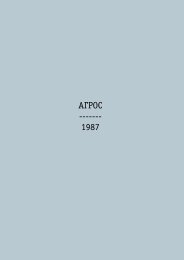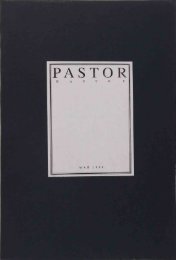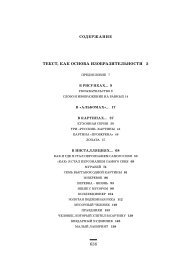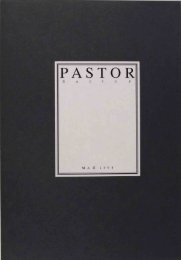макеты-оригиналы хранятся в коллекции художника. Аналогичныйпринцип лежит в основе издания Из жития промокшего старца (1993- 1994), состоящего из двух лепорелло. Черное лепорелло содержит19 инициалов московских художников, обрамленных типовой компьютернойрамкой. Белое лепорелло содержит 19 черно-белыхфотографий тех же художников в детском возрасте. Ироническоекультивирование собственной мифологии и истории зарождениясоавторских групп пробуждает особое уважение к неподдельнойкреативности детского возраста. Так Захаров, начиная с 1994 года,работает над изданием-собранием Пасторская детская библиотека,для которого он подготовил из текстов и иллюстраций своих детей,друзей и художников, сохранивших детскую душу, 25 книг и издал их,разделив на три футляра-выпуска. Как и в случае с журналом Пастор,Захаров охотно берет на себя скромную роль типографа и издателя,предоствляя другим работу над словом и изображением, с тем чтобыв конечном итоге бережно принять всё в свои руки, упорядочитьи оформить. Здесь укрепляется новый нюанс исчезновения, которыйМилена Славицка определила словом ускользание. “Ускользание,например, от какой угодно интерпретации произведения, или отидентификации авторства, как такового”. 2 Эта тенденция обнаруживаетсяу московских концептуалистов в повторяющемся феноменесооавторской деятельности. Так итогом соавторства с СергеемАнуфриевым становится издание Тупик как жанр (1997-98), объединяющеебеседы о различного рода тупиках. Творческое сотрудничествос композитором Иваном Соколовым приводит к тому, чтоСоколов сочиняет Реквием на смерть пирожного Мадлен, который войдетв издание Убийство пирожного Мадлен (1997), документирующееодноименный проект Вадима Захарова на фестивале Штирийскаяосень в Граце.Иной способ исчезновения Вадим Захаров практикует в постоянномразыгрывании ролей, что не только проявляется в многообразиивыполняемых им функций, но к тому же охватывает широкийрепертуар различных персонажей и литературных героев: еще допоявления в постсоветскую эру главного своего героя – Пастора -Захаров выступал в различных проектах как Одноглазый, Пират,Садовник. От черной пасторской рясы, в которую он облачался наhe has published 25 volumes contained in three slipcases oftexts and pictures contributed by his children and those of hisfriends, as well as by artists who have remained children atheart. As in the case of his Pastor periodical, Zakharov likesto assume the modest roles of typographer and publisherand leaves it to others to provide the words and the pictures,which he can then arrange and set out with a few cautioustouches. Here we may discern a new nuance of disappearance,which Milena Slavická has paraphrased with the word“evasion”: “evasion, e.g. of any interpretation of the work orof the establishment of one’s own authorship.” 2 In the caseof the Moscow conceptualists this tendency is manifested inthe recurrent phenomenon of forming groups or engaging inco-productions. Thus Zakharov’s collaboration with SergeiAnufriev was reflected in the publication Dead-end as aGenre (1997-98), a collection of conversations about thevarious kinds of dead ends. The publication entitled TheMurder of the Madeleine Muffin (1997), is also a compilationof texts by various contemporary artists, philosophers andcomposers, which in accordance with an “experimentalsetup” of Zakharov’s were written immediately after the consumptionof a muffin. The background is formed by a remarkableinterweaving of episodes from the novels The Trial byFranz Kafka and Remembrance of Things Past by MarcelProust. What is involved here, according to Zakharov, “ismemory and the collective subconscious, the symbol ofwhich in Proust is the muffin”. The muffin trial ends with thedeath sentence, which was carried out in an action from theSteirischer Herbst in Graz at 7:56 p.m. on 28 September1997. On this sad occasion the musician Ivan Sokolov composeda Requiem on the Death of the Madeleine Muffin,which was also included in the publication.Another form of disappearance practised by VadimZakharov is his constant role-playing, which is not confinedto his various functions, but embraces a whole repertoire ofdifferent personages or literary figures. Before his main roleas the pastor, which Zakharov assumed in the Post-Sovietera, he has appeared in various projects as a “One-EyedMan”, “Pirate” and “Gardner”. In the black cassock of thepastor, which Zakharov has occasionally worn on importantoccasions and appearances, he slips into other roles, thusdonning one mask over another. Once, for example, he setoff for Spain in quest of the Knight of the MelancholyCountenance and, while on the track of Don Quixote,
время важных мероприятий и выступлений, Захаров переходит кследующим ролям, меняя маску за маской. Так он отправляется вИспанию “в поисках рыцаря печального образа”, о чем повествуеттретья книга из серии Смешные и грустные приключения глупогоПастора, проиллюстрированная фотографиями, документирующимипутешествие по следам Дон Кихота и его приключений.Постоянную слепленность в своем творчестве с персонажамиЗахаров связывает с излюбленной традицией многих русских художников,представляющих <strong>Московский</strong> <strong>концептуализм</strong>, таких, например,как Илья Кабаков. Именно в этом смысле Борис Гройс описываетрусского художника “как персонаж из юмористическогоромана”. 3 Постоянная смена перспектив зиждется на принципиальномсомнении, возможно ли представить действительность средствамихудожественно-знаковой системы, будь то идеологическиезнаки социалистического реализма или идеалистические знаковыесистемы современного искусства. Очевидно, структуралистские ипостструктуралистские теории имели в 60 - 80-е годы большое влияниекак на Западе, так и в России. Итак, если не удается овладетьдействительностью с помощью одного из разнообразных визуальныхседств искусства, то остается лишь одна возможность - сделатьтемой искусства саму эту перманентную неудачу. Захаров так и поступает,непрестанно меняя роли на реальной сцене и используя разнообразныевозможности искусства как тексты ролей. При этомречь идет всегда о точно тех же ролях во всех мыслимых вариантах:то это неудачник, то глупый Пастор, не подозревающий своей обреченностина провал. Искусство Московского <strong>концептуализм</strong>а, котороеделается как бы не от своего имени, а от имени созданного персонажа,согласно следующему выводу Гройса, в высшей степенилитературно. 4 Оно связано с традицией русской юмористическойлитературы, с Гоголем, Достоевским, Чеховым, к кототорым Захаровнепосредственно обращается на разных этапах своего творчества.В этом пункте стоит, однако, выяснить, насколько “русский художниккак персонаж юмористического романа” действительно специфическирусский типаж и не возможно ли с таким же успехом отнестиего характеристику к таким художникам, как, например, бельгиецМарсель Бродтерс или канадец Родни Грэхэм. И с тем, и с другимrecreated the latter’s adventures in photographic form, whichhave been brought together in the third book of the Funnyand Sad Adventures of the Foolish Pastor. The fondness forpersonages shown by Zakharov in his work links him to a traditionof Moscow Conceptualism to which Ilya Kabakov isalso committed. This is the sense in which Boris Groysdescribes the Russian artist “as a figure from a humorousnovel”. 3 The constant changes of perspective are due to afundamental doubt that reality can be represented by meansof artistic semiotic systems – whether it be the ideologicalsemiotic systems of Socialist Realism or the idealistic semioticsystems of the modernist movement. It is plain to see thatthe structuralist and poststructuralist theories exerted just asgreat an influence in Russia of the 1960s-1980s as they didin the West. If reality cannot be mastered by any of thevarious visual languages of art, all that remains to be done isto make this permanent failure itself the subject of art.Zakharov does this by constantly switching roles on the stageof reality and using their various artistic languages as thoughthey were various parts in a play. Strictly speaking, this isalways the same role in all its conceivable variations: it is thefigure of the unlucky fellowis chronically unlucky, in this casethe Stupid Pastor who is doomed to failure without realizingit. The art of Moscow Conceptualism, which is seemingly “notdone in its own name” but in that of an in-veted figure, is, asGroys goes on to point out, profoundly literary. 4 It is in thetradition of Russian humorous literature as exemplified byGogol, Dostoyevski and Chekhov, to which Zakharov directlyrefers in various places in his work. At this point one wouldhave to examine whether “the Russian artist as a figure froma humorous novel” really is a specifically Russian character,or whether the description does not equally fit artists like theBelgian Marcel Broodthaers or the Canadian RodneyGraham. Zakharov is linked to both artists by his love of appearingin different roles and functions, his running commentson his own work, his link to 19th century literary figures,a sense of humour that is always that of a victim with anote of melancholy in it – and his ever present love of typography.The aesthetic quality of Zakharov’s works lies in thesupreme refinement of typographical design which, despite amodest recognition of its ancillary function, stands in subtlerelation to the content. Despite all their variations in formats
- Page 2 and 3:
ЕЖЕГОДНЫЙ МЕЖДУНАР
- Page 5:
Объекты радикально
- Page 9 and 10:
Большого театра. Ка
- Page 11 and 12:
мы, её динамики, её
- Page 13 and 14:
является архивом, а
- Page 15 and 16:
Автопортрет с завя
- Page 17 and 18:
Кабачок/ Kabachok (Marrow Sq
- Page 19 and 20:
Портрет В. Захарова
- Page 21 and 22:
Потерянный день/ Lost
- Page 23 and 24:
Краткая история со
- Page 25 and 26:
Краткая история со
- Page 27 and 28:
1. Трещины на стене.2
- Page 29 and 30:
1. Магнитофон «Grundig»
- Page 31 and 32:
1. Саксофон, выданны
- Page 33 and 34:
1. Сломанный электр
- Page 35 and 36:
1. Бонги, принесенны
- Page 37 and 38:
1. «Наш флаг», изгот
- Page 39 and 40:
Портрет Монастырск
- Page 41 and 42:
В 1986 г. Герман Виног
- Page 43 and 44:
Художники! Прошу не
- Page 45 and 46:
Рисунок к изданию П
- Page 47 and 48:
Сирень/ Lilac, 1987СЕРГЕ
- Page 49 and 50:
Без названия/ Untitled,
- Page 51 and 52:
Шпиц/ Spitz, 1988
- Page 53 and 54:
АНАТОЛИЙ ЖУРАВЛЕВAN
- Page 55 and 56:
Я никогда ничего не
- Page 57 and 58:
Пролетарии, на пара
- Page 59 and 60:
Рисунок к изданию П
- Page 61 and 62:
Филенидка/ Filenidka, 1985
- Page 63 and 64:
Лукъянчик/ Lukjanchik, 198
- Page 65 and 66:
Труп отца!/ Father's Corpse
- Page 67 and 68:
Мне с нею познакоми
- Page 69 and 70:
Моя бабушка .../My Grandm
- Page 71 and 72:
ЕЛЕНА ЕЛАГИНАELENA ELAG
- Page 73 and 74:
Вредители/ Pests, 1999
- Page 75 and 76:
Спальный мешок из с
- Page 77 and 78:
Кережка и волокуша
- Page 79 and 80:
Исход/ Exodus, 1976, 1983ИГ
- Page 86 and 87:
Серию Выбор цели я
- Page 89 and 90:
Лозунг КД (Коллекти
- Page 91 and 92:
Made in Slum/ Made in Slum, 2007
- Page 93 and 94:
АНДРЕЙ МОНАСТЫРСКИ
- Page 95 and 96:
Посвящение Вадиму
- Page 97 and 98:
Смерть мухам / Death to
- Page 99 and 100:
Глубокая задумчиво
- Page 101 and 102:
ВЛАДИМИР НЕМУХИНVLAD
- Page 103 and 104: Валет. Из серии рис
- Page 105 and 106: ПАВЕЛ ПЕППЕРШТЕЙНPA
- Page 107 and 108: Динарий Кесаря/ Cesar
- Page 109 and 110: Поединок Номы и Сов
- Page 111 and 112: ВИКТОР ПИВОВАРОВVIKT
- Page 113 and 114: Донесение о состоя
- Page 115 and 116: ДМИТРИЙ ПРИГОВDMITRI P
- Page 117 and 118: Рисунок к изданию П
- Page 119 and 120: Без названия/ Untitled,
- Page 121 and 122: Артек/ Artek, 1989
- Page 123 and 124: АНДРЕЙ РОЙТЕРANDREI ROI
- Page 125 and 126: ВИКТОР СКЕРСИСVIKTOR S
- Page 127 and 128: Модель искусства /Th
- Page 129 and 130: Музыкальные инстру
- Page 131 and 132: Машина Юстиции / Machi
- Page 133 and 134: Лес / The Forest, 1985
- Page 135 and 136: АНДРЕЙ ФИЛИППОВANDREI
- Page 137 and 138: Приглашение на ужи
- Page 139 and 140: ЧЕМПИОНЫ МИРАГиа А
- Page 141 and 142: Таймс / The Times, 1986
- Page 143 and 144: Эта работа первона
- Page 145 and 146: Рисунок к изданию П
- Page 147 and 148: Без названия (Лодки
- Page 149 and 150: Серия рисунков, соб
- Page 151 and 152: До р о т е я Цв и р н
- Page 153: актуальные проблем
- Page 157 and 158: Пастор Nr.1 - Имена / Pa
- Page 159 and 160: Никита Алексеев, Юр
- Page 161 and 162: Иллюстрации к Детс
- Page 163 and 164: В ос но ву из да ния
- Page 165 and 166: Достаточно легкого
- Page 167 and 168: Вла д и м и р На у м е
- Page 169 and 170: For the sake of simplicity a diagra
















